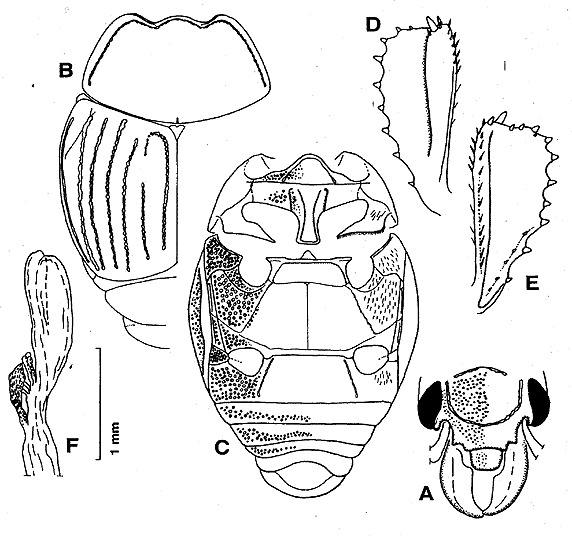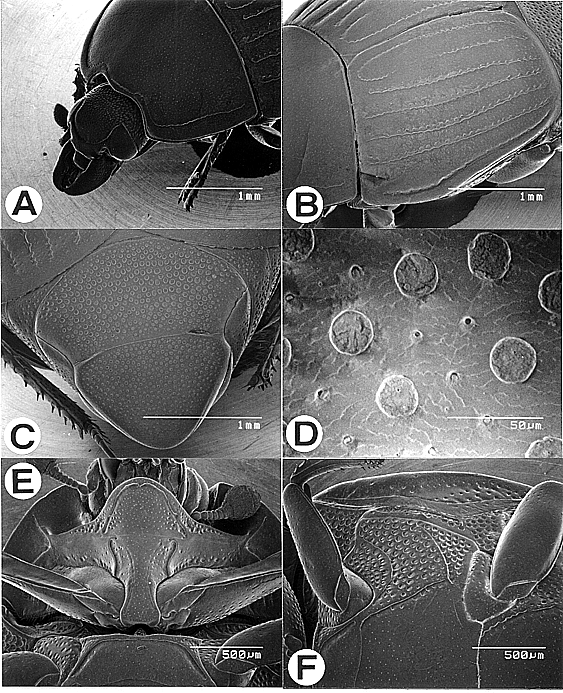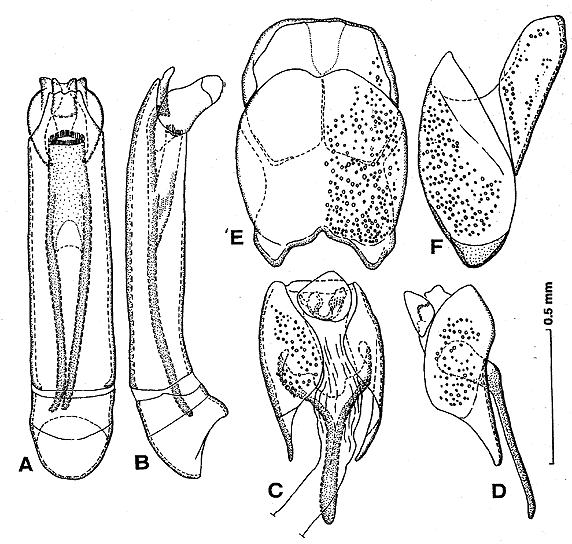Margarinotus (Grammostethus) curvicollis (Bickhardt,
1913)
Hister (Grammostethus) curvicollis Bickhardt, 1913, 172 [Taiwan: Kankau,
Koshun (= Hengchun), Ping-tong Hsien]; Miwa, 1931, 57 [Kôshun]; Kamiya
and Takagi, 1938, 31.
Grammostethus curvicollis: Lewis, 1915, 55 [listed].
Margarinotus curvicollis: Wenzel, 1944, 126 [listed].
Margarinotus (Grammostethus) curvicollis: Mazur, 1984, 175 [cataloged].
Description (Ohara, 1999).
Male. PPL, male, 4.0-4.1 mm, female, 4.0 mm, PEL, male, 3.0-3.05 mm,
female, 3.05 mm. Width, male, 2.70-3.01 mm, female, 2.7 mm. Biometric data
are given in Table 2. Body oval, black and shining; legs, antennae, mouth
parts, lateral area of propygidium and a broad area along basal margin of
pygidium reddish-brown.
Frontal stria of head (Fig. 4A) complete, subcariniform and regularly
curved anteriorly. Disk of head moderately punctate with microscopic punctures
intermingled, the punctures becoming coarser along basal margin.
Anterior margin of pronotum (Fig. 4B) bisinuate, the median portion regularly
and outwardly arcuate. Marginal pronotal stria complete laterally, and broadly
interrupted behind head. Lateral stria complete, subcariniform and strongly
crenate, its apical portion behind head regularly arcuate; the stria sometimes
interrupted behind eyes. Disk of pronotum evenly covered with moderate punctures
and with microscopic punctures intermingled. Antescutellar area feebly depressed
and with a longitudinal puncture.
Epipleural fossette sparsely covered with coarse punctures along outer
margin. Marginal elytral stria absent. Marginal epipleural stria complete
and well impressed. External subhumeral stria (Fig. 4B) complete and deeply
impressed. Internal subhumeral stria absent. Oblique humeral stria present
on basal third. First 4th dorsal striae complete, well impressed and
strongly crenate. Fifth dorsal stria present on apical half, with a long
rudiment on basal fourth. Sutural stria complete, usually its basal end
connected with basal rudiment of 5th dorsal stria by an arc. Surface of
elytra densely covered with fine punctures.
Pygidia feebly alutaceous (Fig. 5C). Propygidium with an elevation on
lateral area and a feeble depression behind each posterior angle; surface
densely covered with large and shallow punctures, which are separated by
their own diameter to one-fourth the diameter; fine punctures intermingled
among the large punctures. Punctation of pygidium similar to propygidial
one, but sparser and fine, becoming finer apically.
Prosternal lobe rounded at apex (Fig. 4C, 5E), its marginal stria well
impressed, subcariniform and complete; disk covered with coarse punctures.
Prosternal keel with carinal striae on its whole length.
Anterior margin of mesosternum (Fig. 4C, 5E) nearly straight, its marginal
stria complete and subcariniform, and with another short stria behind each
anterior angle. Disk of mesosternum sparsely clothed with fine punctures.
Meso-metasternal suture complete, subcariniform and sinuate. Lateral stria
of metasternum (Fig. 5F) extending obliquely and posteriorly, and united
with oblique stria that extends inwards from the middle of metasternal-metepisternal
suture. Intercoxal disk of metasternum sparsely clothed with fine punctures,
and with coarse punctures along the lateral stria. Lateral disk of metasternum
densely covered with large and shallow punctures; without hair.
Intercoxal disk of 1st abdominal sternum striate on each side and finely
punctate, the punctures becoming coarser laterally.
Protibia with 8 denticles on external margin (Fig. 4D, E). Profemur with
short posterior marginal stria on apical fifth.
Male genitalia as shown in Fig. 6. Ratio in length of parameres to basal
piece about 3.5.
Female genitalia as shown in Fig. 4F. Spermatheca consisting of 5 small
sacs.
Specimens examined.
[Proper] Taoyuan Hsien: Palin (1 male, 26/iii/1986), M. Ohara. Hsinchu
Hsien: Shangping (1 male, 1, 2/v/1986), K. Masumoto. Nantou Hsien: Meiyuan
(1 male, 21/v; 1 female, 24/v/1981), Chin-Kin Yu.
Distribution. Taiwan.
Remarks. This species is easily distinguished from the other Taiwanese
Histerini by the color pattern of the propygidium and pygidium. Mazur (1975)
described an allied species, M. (G.) meridionalis, from India. M. curvicollis
belongs to the type of ruficornis in regard of the structures of the male
genitalia (Ohara, 1989).

Fig. 4. Margarinotus (Grammostethus) curvicollis (Bickhardt). A: Head,
frontal view. B: Pronotum and left elytron. C: Ventral side of adult. D:
Left protibia, dorsal view. E: Ditto, ventral view. F: Female genitalia,
spermatheca, vagina and bursa copulatrix, lateral view (left side). [AE:
no. 9923, Meiyuan; F: no. 9924, Meiyuan]. (Ohara, 1999). (Ohara, 1999).

Fig. 5. Margarinotus (Grammostethus) curvicollis (Bickhardt). A: Head
and pronotum, oblique view. B: Left elytron, oblique view. C: Propygidium
and pygidium, caudal view. D: Punctation of pygidium. E: Prosternum, ventral
view. F: Mesosternum, metasternum and epipleura of elytron, ventral view.
[A-D: no. 9923, Meiyuan, Nantou; E-F: no. 9940, Palin, Taoyuan]. (Ohara,
1999).

Fig. 6. Margarinotus (Grammostethus) curvicollis (Bickhardt). Male genitalia.
A: Aedeagus, dorsal view. B: Ditto, lateral view. C: Ninth and 10th tergites,
dorsal view. D: Ditto, lateral view. E: Eight tergite and sternum, dorsal
view. F: Ditto, lateral view. [AF: no. 9923, Meiyuan]. (Ohara, 1999).
Histeridae/Histerinae/Histerini/Margatinotus/References



